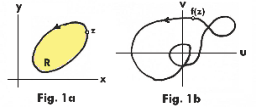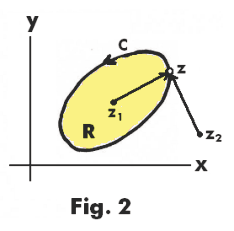
Website owner: James Miller
Zeros, poles, Argument principle, Rouche’s theorem
Zeros and poles

Let f(z) be analytic inside and on a simple closed curve C, except for possibly a finite number of poles in the region R inside C. Consider the curve that is traced out in the w plane by f(z) as the point z goes around C once in the positive direction. As z goes around C, f(z) describes some closed curve. See Fig. 1. How f(z) behaves depends on the number of zeros and poles of f(z) in R.
Case 1. There are no poles in R. Suppose f(z) has one simple zero in R. Then as z goes around C once in the positive direction, f(z) will wind around the origin once in the positive (counterclockwise) direction. Suppose there are two simple zeros in R. Then as z goes around C once in the positive direction, f(z) will wind around the origin twice in the positive direction. Suppose there is one zero of order three in R. Then as z goes around C once in the positive direction, f(z) will wind around the origin three times in the positive direction.
Case 2. There are no zeros in R. Let f(z) have one simple pole in R. Then as z goes around C once in the positive direction, f(z) will wind around the origin once in the negative (clockwise) direction. If there is one pole of order 3 in R, then as z goes around C, f(z) will wind around the origin three times in the negative direction. If there are 3 simple poles in R, then as z goes around C, f(z) will wind around the origin three times in the negative direction.
Case 3. There are both zeros and poles in R. Suppose f(z) has one simple zero and two simple poles in R. Then as z goes around C once in the positive direction, f(z) will wind around the origin once in the negative direction. Suppose f(z) has three simple zeros and one simple pole in R. Then as z goes around C once in the positive direction, f(z) will wind around the origin twice in the positive direction.
Thus we see that as point z makes one trip around C in the positive direction, f(z) makes n trips around the origin where n is given by the total number of zeros within C minus the total number of poles within C. If n is negative it indicates trips in the negative direction. A zero (or pole) of order m is counted as m zeros (or poles).
How f(z) behaves as z goes around C can also be expressed in terms of the change in the argument of f(z), Δ arg f(z), when z makes one trip about C. If there is a single zero and no poles, Δ arg f(z) = 2π. If there are three zeros and no poles, ΔC arg f(z) = 3 ·2π = 6π, etc.
Let us now consider an example that will give insight into what is happening. Let f(z) be the polynomial
1) f(z) = a0zn + a1zn-1 + ... + an = a0(z - z1)(z - z2) ... (z - zn)
which we have decomposed into linear factors. The numbers z1, z2, ... , zn correspond to the zeros of f(z).
From the formula
![]()
we know the product of several complex numbers is equal to the sum of the arguments of the factors. Thus
2) arg f(z) = arg a0 + arg (z - z1) + arg (z - z2) + ........ + arg (z - zn) .
Let Δ arg f(z) be the change in the argument of f(z) when z makes one trip about C. Then Δ arg f(z) will be equal to 2π times the number of times the point f(z) winds around the origin. Now it is clear that when z makes one trip about C
3) Δ arg f(z) = Δ arg a0 + Δ arg (z - z1) + Δ arg (z - z2) + ........ + Δ arg (z - zn) .

Now Δ arg a0 = 0 since a0 is a constant. We note that z - z1 corresponds to a vector extending from point z1 to point z. Let us assume that z1 lies in the interior of the region. See Fig. 2. From the figure it is clear that as the point z goes around the curve C the vector z - z1 makes a complete revolution about its initial point. Consequently Δ arg (z - z1) = 2π. Let us now assume that point z2 lies outside the region as shown in the figure. In this case the vector z - z2 moves from side to side and returns to its original position without making a revolution about its initial point. Thus Δ arg (z - z1) = 0. We can reason the same way about all the roots. Thus Δ arg f(z) is equal to 2π times the number of roots of f(z) lying in the interior of the region. And the number of roots inside the region is equal to the number of times the point f(z) winds around the origin.
We just considered a function that had zeros and no poles. Let us now consider one with poles. Consider the function

Here q1, q2, ... , qm are the zeros and p1, p2, ... , pn the poles of f(z). Then
5) arg f(z) = arg a0 + arg (z - q1) + arg (z - q2) + ........ + arg (z - qn)
- arg b0 - arg (z - p1) - arg (z - p2) - ........ - arg (z - pn)
When z makes one trip about C, Δ arg f(z) is given by
6) Δ arg f(z) = Δ arg a0 + Δ arg (z - q1) + Δ arg (z - q2) + ........ + Δ arg (z - qn)
- Δ arg b0 - Δ arg (z - p1) - Δ arg (z - p2) - ........ - Δ arg (z - pn)
We now reason exactly as we did in the previous example. If the pole p1 is inside C, then as the point z goes around the curve C the vector z - p1 makes a complete revolution about its initial point. Consequently Δ arg (z - p1) = 2π. In 6) this increment has a negative sign attached to it, so it is subtracted from the total for Δ arg f(z). All zeros and poles lying inside the region contribute to the total for Δ arg f(z). Contributions from the zeros are added and contributions from the poles are subtracted. Zeros and poles lying outside the region don’t contribute. Thus Δ arg f(z) is equal to 2π(N - P) where N is the number of zeros and P is the number of poles inside C. The number of times the point f(z) winds around the origin is given by N - P.
Theorem 1. If f(z) is analytic inside and on a simple, closed curve C , except for a pole of order p at z = a inside C, then

If f(z) is analytic inside and on a simple, closed curve C , except for a zero of order n at z = a inside C, then

Theorem 2. Let f(z) be analytic inside and on a simple, closed curve C , except for j poles of
orders m1, m2, ... mj at points α1, α2, ..., αj and k zeros of orders n1, n2, ... nk at points β1, β2, ..., βk,
all located in the region inside C. Suppose that f(z)
![]() 0 on C. Then
0 on C. Then

If, in the above theorem, we let P = m1 + m2 + ... + mj and Z = n1 + n2 + ... + nk,
then
![]()
Argument principle. Let f(z) be analytic inside and on a simple closed curve C, except for a finite number of poles inside C. Let Z and P be the number of zeros and poles (multiplicities counted, each zero or pole counted a number of times equal to its order) inside C. Let Δ arg f(z) be the change in arg f(z) as z makes one trip about C in the positive (counterclockwise) direction. Then
Δ arg f(z) = 2π (Z - P)
Theorem 3. Let C be a simple, closed curve and R be the open region interior to C. Let f and g be functions analytic on C and its interior R, except for a finite number of zeros and poles in its interior, and satisfying | f | > | g | on C. Then the difference between the number of zeros and poles of f in R (multiplicities counted, each zero or pole counted a number of times equal to its order) is equal to the difference between the number of zeros and poles of f + g in R.
Rouche’s theorem. If f(z) and g(z) are analytic inside and on a simple closed curve C and if |g(z)| < |f(z)| on C, then f(z) + g(z) and f(z) have the same number of zeros inside C.
References
Mathematics, Its Content, Method and Meaning. Vol. I
Wylie. Advanced Engineering Mathematics
Hauser. Complex Variables with Physical Applications
Jesus Christ and His Teachings
Way of enlightenment, wisdom, and understanding
America, a corrupt, depraved, shameless country
On integrity and the lack of it
The test of a person's Christianity is what he is
Ninety five percent of the problems that most people have come from personal foolishness
Liberalism, socialism and the modern welfare state
The desire to harm, a motivation for conduct
On Self-sufficient Country Living, Homesteading
Topically Arranged Proverbs, Precepts, Quotations. Common Sayings. Poor Richard's Almanac.
Theory on the Formation of Character
People are like radio tuners --- they pick out and listen to one wavelength and ignore the rest
Cause of Character Traits --- According to Aristotle
We are what we eat --- living under the discipline of a diet
Avoiding problems and trouble in life
Role of habit in formation of character
Personal attributes of the true Christian
What determines a person's character?
Love of God and love of virtue are closely united
Intellectual disparities among people and the power in good habits
Tools of Satan. Tactics and Tricks used by the Devil.
The Natural Way -- The Unnatural Way
Wisdom, Reason and Virtue are closely related
Knowledge is one thing, wisdom is another
My views on Christianity in America
The most important thing in life is understanding
We are all examples --- for good or for bad
Television --- spiritual poison
The Prime Mover that decides "What We Are"
Where do our outlooks, attitudes and values come from?
Sin is serious business. The punishment for it is real. Hell is real.
Self-imposed discipline and regimentation
Achieving happiness in life --- a matter of the right strategies
Self-control, self-restraint, self-discipline basic to so much in life